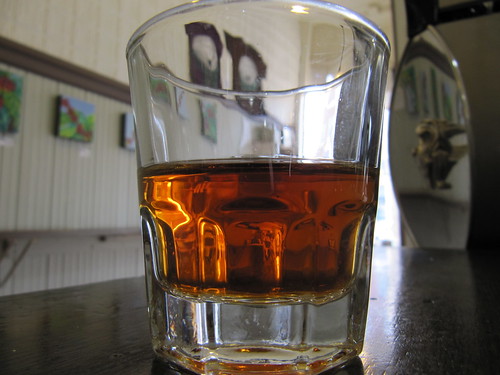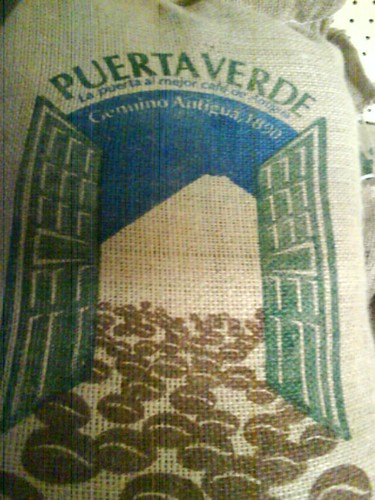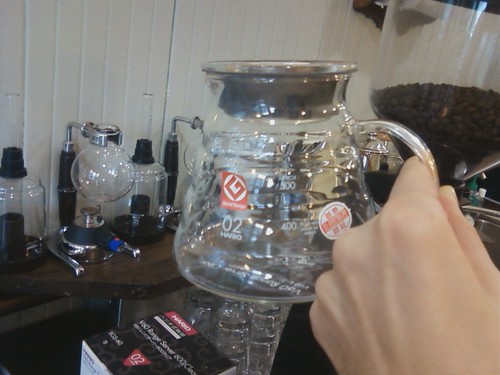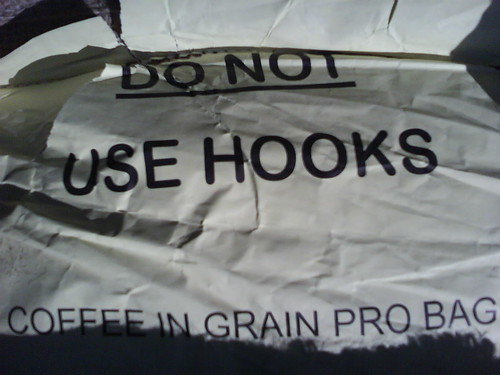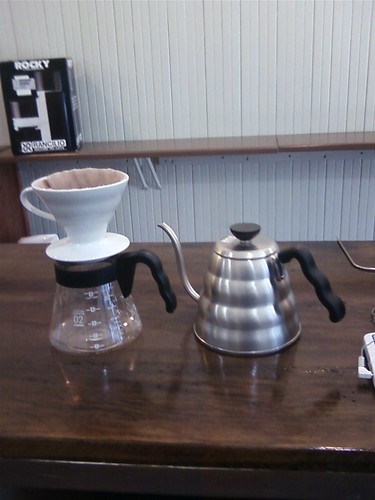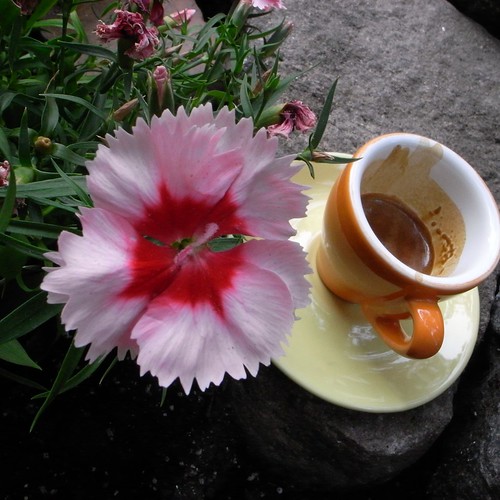Tuesday, December 29, 2009
Hario 'woodneck' design and some thoughts on hand pour
Sunday, December 20, 2009
Pour over videos from Taiwan/Japan
The following is a famous very old school Japanese roaster doing his pour over method on TV. His book on coffee roasting and brewing is interesting, techniques on double roasting, dark roasting, and the benefits of aging/aged coffees. About as far from barismo philosophy as you can get so you will understand we are not endorsing this method, it's just interesting to view. I personally think the bit at the end where the hosts get into the brewing is the most entertaining part.
Next up is Jet from Bella Taiwan doing a quick and easy continuous single 1 cup 2 minute brew. It's closer to methods we like to use at the moment on our own coffees for a 1 cup but the timing may be different. Of course, every coffee behaves differently and so do different roast styles so match it to personal taste.
After that is a demo of the stop and go method. We use variations of this for larger 2 and 3 cup brews. It involves pouring a little faster and relies on setting the grind well to control the drainage. I had been using this style for a one cup until I finally got comfortable with the continuous pour.
The last video is the type of method I understand Osir of Taiwan does. It involves a coarse grind, lots of volume, and a rapid continuous pour. This method seems more in line with the old school Japanese methods I have seen but it's not one we use.
So there are some basic pour over ideas to get people started.
Wednesday, December 16, 2009
Catching up with old friends
I have just recently gotten back from a week and a half tour of Taiwan and a brief stop in Tokyo, Japan. It will take me a little while to collect my thoughts and organize my photos but there is a lot to discuss. Tea farms, equipment manufacturers, and a drop in with Hario Japan that all will be discussed in the next few weeks.
First off, it's worth noting something that came as a shock to us. Just after visiting with Simon Hsieh in Taipei, we discovered Simon scored two very high scores on coffeereview to take the top two spots in a ranking of 2009 best sellers. I want to say congratulations to Simon and I hope he gets worthy notice for his roasting skills and ability. As a student of his in roasting and brewing methods, I can only wish him well.
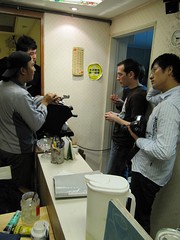
Strangely enough, we finished 4th in the same poll rather unexpectedly. The request for coffees to be reviewed was for best sellers of 2009, not the sexy premium lots but the ones that have performed well in sales. I believe at the time we sent the coffees, we were nearly out of our Costa Rica Helsar de Zarcero and just discontinued our Kenya Kiandu in drip so our lineup was slim.
The Koke scored a 94pt review which we'll happily accept. We only roast this coffee as an espresso as it is very popular in our cafe accounts and is a component of more than one of the Sonata series espresso blends. Since we only roast it as espresso, we took a risk that it would not fare well on the cupping table but we came out fine.
Simon and I only had a short time to exchange coffees, catch up, and brew some Syphon before we had to keep on schedule but it was good seeing him again.
Saturday, November 28, 2009
Guest barista at barismo
First up will be Jake from ERC (Dec 4th). Jake is the coffee manager for ERC and Pavement (opening soon). Next up will be Jacob from ERC @ BU (Dec 8th) followed by Judson from Hi Rise Cafe (Dec 11th). Judson finished first in the Espresso competition at the Fri 13th Jam, Jacob was runner up in the latte art competition. We'll have several guest barista who are familiar with our coffee first up but the idea is to share a different perspective. We will be inviting other barista and already have confirmations. Keep in mind, most guest stints are not usually local shops to local shops so this is a bit of a novelty. We will post the schedule the week before each guest.
The idea is to have a dialogue with barista. We have a lot to offer and getting outside perspective is a good thing. The idea is to let barista work on a coffee bar where the customers are very supportive and the culture is open to creative brew methods. If the larger coffee culture is going to change, it has to change on all fronts, not just those that serve our coffees. Coffee needs to get away from this latte centric phase some shops locally are pushing hard for. We probably don't need a focus on the 4 shot 20oz latte and syrups as much as we need to get back to the basics, the coffee itself.
Sounds strange and I know many people won't get it, but that's the risk in this. In a worst case scenario, only a few barista are interested and the effect is pretty minimum. At best, we learn something and barista walk away with a little initiative to bring back some of the ideas we are using on our bar. We get to hear outside perspectives of the challenges in cafes and that helps us build a more comprehensive approach to how we further the concept of creating demand for better coffee.
The issue here is simple. We want to share a portion of what we know and build the local community even if it means helping people who do not work with us or our coffees. Our goals are larger than the old timer's territorial politics. To get better, we all have to move a step forward. If that means we have to lead, so be it, antagonize a bit, sure, why not? There is always a risk in doing something about quality rather than just talking about it.
Tea
Volume, selection, and cheap prices are the norm around here for our leafed brews. Tea has never gotten a real stage here and there are a multitude of reasons.
The big difference between coffee and tea is the learning curve involved. Teas may be easier to brew but in coffee, anyone who pours a rosetta can and does claim expertise.
There is no equivalent in tea which can make it's presentation or service valuable to the newbie barista. Unlike coffee, there are few ways beyond taste to contrast the visual appearance related to it's quality. The depth of options available coupled with the lack of access to top quality puts teas as a second tier product in most cafes.
The best teas receive extremely high prices in other countries and the US market has a relatively weak demand for higher priced teas. Even tasting a properly brewed competition grade Oolong would be an incredibly rare experience.
We are lucky in the US when it comes to coffee. We're geographically close to some of the best coffees in the world and the costs are still affordable to taste the premium coffees. It may not always be that way so enjoy it now.
As I head off to visit tea farms, I'll be thinking about just this. I'll try to bring home a unique Tea experience to share and hopefully the taste alone will be enough to inspire more focus on teas as well as the usual coffee attention we all have.
Tuesday, November 24, 2009
How to: The v60 1 cup 9 ounce method
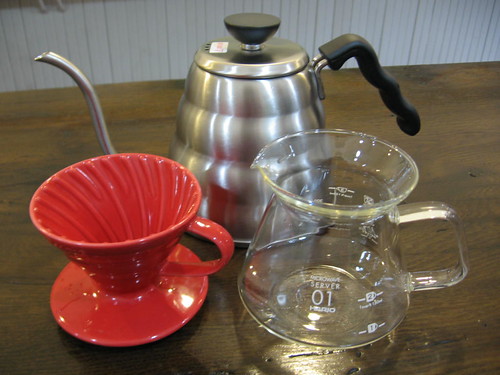
1 cup Range server, 1 cup v60, and Kettle
You will need:
Kettle
v60 1 cup
*1 cup range server
v60 filter (paper or cloth)
A gram/ounce scale
Thermometer (preferably digital)
Coffee and Grinder
Filtered hot water
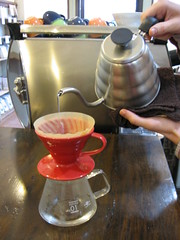 The following method is for a 9 ounce cup to approximate traditional US style drip coffees. With a slightly adjusted grind and slower speed of pour, a smaller resulting volume in the same amount of time can be brewed for more intense origin characters.
The following method is for a 9 ounce cup to approximate traditional US style drip coffees. With a slightly adjusted grind and slower speed of pour, a smaller resulting volume in the same amount of time can be brewed for more intense origin characters.1. Rinse filters (cloth or paper) before each use with water off the boil. This will remove some unwanted tastes and warm the v60 itself. A rinse also helps hold the paper filters into place.
2. Use a cloth underneath the kettle when pouring for balance and to avoid burns. For best results with the Hario Kettle, a slight tilt on it's side can help control the slower pour speeds.
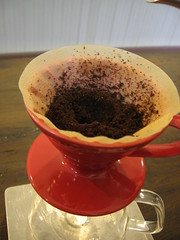
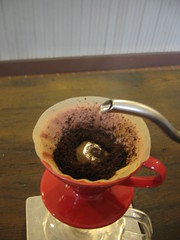
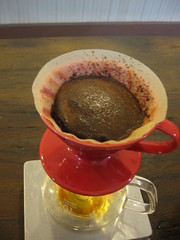
3. After freshly grinding freshly roasted coffee, load 19g (+ or - to taste). Indent a small impression in the center of the grounds. It makes a difference for beginners in v60 to get an even pre-wet. It is extremely important to makes sure all the grounds are fully wet during this stage as dry areas will cause bubbling and channeling later in the brew.
4. Once water is ready off boil, allow it to cool to desired temperature (88C-92C OR 190F to 198F). Darker roasts will need lower temps while lighter roasts need higher temps as general rule.
5. Pour one ounce of water slowly into the center of the ground coffee then continue with deliberate circles outward until all grounds are wet. This should take a total of 10 seconds to completely wet the grounds.
6. Start your timer with a two minute count.
7. Allow the coffee to bloom for twenty seconds (+ OR - 10 seconds) after the last drip of the pre-wet pour. Some roasts will not bloom due to age or roast style, these make for difficult pour overs but can be rewarding with attention.



8. Once the timer starts, allow the coffee to bloom and soak. In this example, we allowed it to sit for twenty seconds before pouring. The initial pour after pre-infusion is important because we want the grounds to unfurl evenly into a V shape as we slowly pour into the center. An errant or too fast pour can cause side channeling and it's best to avoid this. Pouring down the sides is also not recommended as this will agitate grounds and cause bitters in the brew. A reminder, this is not a pour and fill method so water that does not pass through the coffee will simply drain off quickly. The floating dome that forms an inch around the outside of the brew has an insular effect and it is not necessary to break this during the pour. In fact, results of washing the edges on the final pour have been very unpleasant.
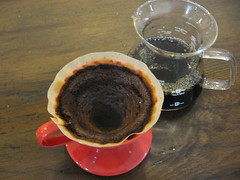 9. For this method, a steady pour of nine ounces from the twenty second mark until there are thirty seconds left on a two minute count has worked best. If the grind is set correctly, the last few drips will happen at or just after the timer goes off. For a larger v60-02, we would add a minute to the total time and adjustments to grind/dose/pour.
9. For this method, a steady pour of nine ounces from the twenty second mark until there are thirty seconds left on a two minute count has worked best. If the grind is set correctly, the last few drips will happen at or just after the timer goes off. For a larger v60-02, we would add a minute to the total time and adjustments to grind/dose/pour.10. The resultant grounds should be evenly distributed and symmetry isn't necessarily a bad thing! Take notes, make adjustments and record the effects of those changes. A method can always be tuned from it's starting point to personal tastes.
Get started on this with the pour over mini pro pack.
For brew guides and other methods visit our education section.
Monday, November 23, 2009
v60 is better

v60- bloom diagram
Compared to other manual methods, v60 is unique because you have control over flow rate. In most every brew method, we can control the temperature, dose and grind. What's difficult is to control the flow rate or water debit in most manual brews.
Pour and fill methods like Melitta and Chemex are restricted by grind and drainage orifice. V60 has the signature ridged sides which allow for ventilation and side drainage while the drain orifice is large and won't restrict flow. A Chemex cannot drain from the sides and Melitta is restricted by the orifice, v60 has neither problem.
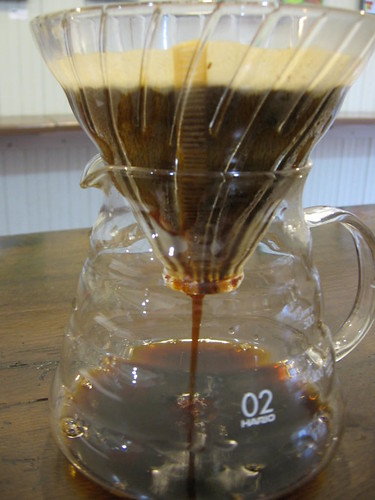
What has been problematic so far with v60 is that many people are just brewing it like a Chemex and that does not produce the same results v60 were designed to achieve. Much attention needs to be put on the bloom and a proper preinfusion with a controlled pour technique. The results can be seen in an evenly extracted v shape in the brewed grinds.

For better results with the v60, start with one of our brew guides (available on request with an order) and adjust to taste. We will be posting a 1 cup how to guide soon. For wholesale or commercial training requests on any of the Hario products, please contact us directly as we will be happy to assist.
Sunday, November 22, 2009
Moving forward
The plan once we get back will be quite ambitious. We have new shops opening using our coffee that will need our training and support. In that same time, we will be looking to audit our existing accounts/relationships and see how we can help them progress towards better coffee service in the local area. Classes, training sessions, and an ambitious barista certification program are on the list. I approach it with the idea that if you aren't moving forward, you are falling behind.
We are working behind the scenes diligently on several projects so our hands are quite full right now. The most exciting project with local community implications will be related to competitions. More on that and several equipment projects that we can talk about soon, but not yet.
Friday, November 20, 2009
Boston's coffee community
It was the sound of barista furiously clicking that Mazzer doser to distribute freshly ground espresso into the portafilter. This may sound strange but given everything we've gone through to get to this point, it's comforting. Thinking about where some of these shops and barista will be in 6 months and how far they have come in the last six months puts me in a good mood.
To come to this point is very exciting because the next year in front of us will be another challenge in training, competitions, and better coffee in the area. If we trained one barista to place in in a regional competition, we can train more. If our accounts keep growing, so will we. So to those who predicted or hoped we wouldn't be around in a year, you might be sore out of luck.
After the jam (second we've helped organize), I realized a few things. In a few months, the dynamic of who the best shops in Boston are will shift again. With that, I hope the dialogue can get off photos of 20 ounce latte art in the press and back onto coffee. It's a bit embarrassing really that Boston hasn't yet emerged from this cheap/volume phase yet with cafes claiming to be top tier. The nonsensical focus on jumbo milk art reminds me of the early New York coffee scene and the press attention it got. When the discussion is on the coffee, why we should pay more for better coffee, and how to provide an experience equal to that higher dollar amount, that's progress. Cheap 16oz cups of house light/dark is not progress for any shop trying to claim best quality in the area.
Boston has a young community built around coffee that is starting to move. Most of the progressive shops are splitting roast suppliers and there is positive momentum toward smaller/better quality cup sizes and per cup bars. I'm excited and hopeful. Things are changing, be it from the peer pressure of a big coffee event or simply new personalities influencing changes. For our part, we'll keep reinvesting in the larger community, even those that don't serve our coffees. The goal is to grow a bigger local base of shops and therefore end consumers who appreciate attention to quality in coffee.
Wednesday, November 18, 2009
Barista Jam Aftermath
Results of the competitions:
Coffee Triangulation organized by Atomic (Beverly, MA):
1. Mike (Cambridge, MA)
2. Jamie W. of Barismo (Arlington, MA)
3. Melissa W. of ERC (Boston, MA)
Espresso Throwdown organized by barismo (Arlington, MA):
1. Judson M. of Hi-Rise on Brattle St. (Cambridge, MA)
2. Scott B. of Cafe Fixe (Brookline, MA)
3. Markus of ERC @ BU(Boston, MA)
Latte Art Pour organized by ERC/MEMteas:
1. Nik of Taste Cafe (Newtonville, MA)
2. Jacob of ERC @ BU (Boston, MA)
3. Ethan Miller (New Hampshire)
Wednesday, November 11, 2009
Upcoming mid November events
Sat 14th Brew Bar/Tasting @ Dave's Fresh Pasta 81 Holland St Somerville 1-3pm
The Jam is going to be huge. Help make it a success by showing up!
After the jam, take some time to support local specialty shops and check out the tastings at Formaggio and Dave's. Kenya, Costa Rica, Guatemala, Oh My!
Friday, October 23, 2009
Label changes and new SOMA

Soma espresso is back out again with a new base. Our new Guatemala, La Trinidad, will work as the base for this blend in the foreseeable future. Armando Melgar's Finca la Trinidad is a coffee that has deep base notes and provides a round body for the sparkle of the Kenya component. We will be producing SOMA in editions with each of our Kenyas featured in this blend. We will start with the last of our Kenya Kiandu and then move over to Kiamabara followed by Kieni.
With the new espresso, we decided to do an art label and have some fun. SOMA will switch back and forth between an art label on the front with the classic label on the back to the classic label on front with more brewing and quality preserving information on the back. We are moving towards adding brewing tips, storage tips, and more detailed information about the coffees in finer print on back labels.
Keep an eye out for it in the next few weeks.
Thursday, October 22, 2009
Similarities between rice and coffee storage
 Rice is about as commodity as it gets. Well, I like to think that but then I have been noticing that even with something like rice, care given to packaging is moving well ahead of what we deal with in green coffee.
Rice is about as commodity as it gets. Well, I like to think that but then I have been noticing that even with something like rice, care given to packaging is moving well ahead of what we deal with in green coffee.A trip to the local mega asian grocer (Kan Man in Quincy) led me to make note of a few interesting things with one strong observation, the packaging is getting serious.
At our local Korean grocer in Union Sq. Somerville, there is an assortment of rice available in many grades. What's interesting about it was how they noted crop year and an emphasis on packing as each bag had it's own 'patent pending' method of storage. Most of which seemed to be nitrogen flushed or tightly vacuum sealed which I must say does seem to make a difference.

In wandering around Kan Man viewing the stacks of vacuum sealed rice varieties stacked on the shelf, that I had a good chuckle. So much obsession over rice, a product I have been used to seeing in bags akin to dog food packaging. Then it hit me how young our coffee industry is and how absurdly ironic it was.
The fact that preservation packaging is still such a novel and absurd idea really instills a sense of how far coffee still has to go and just how far behind it is. The truth is that there is so much information out there to digest and yet not nearly enough quality data therein. Like most things coffee, too many opinions and not enough data or research being done.
Without vacuum packaging, our business would not be enjoying it's first year in celebration. Putting it in perspective, packaging for preservation makes a difference and we have the experiences under our belt to prove it. If other people don't agree with us, that's fine because everyone needs to learn their own lessons but we know what works and will keep working with it.
As the weather turns, let's keep an eye on the temperature and think about the effort that goes at every stage into one taste of coffee down the line. There are so many things that can destroy a coffee from the time is is picked through processing, transport, the roast, and then with brewing at the barista level. It does not begin and end solely in the hands of a barista, it's a process that started months ago and continues even while sitting in a warehouse.
Thursday, October 08, 2009
Friday the 13th barista jam November, 2009

Posters will be going out ASAP to many shops and respectable coffee houses. For a poster or flier, contact us at baristajam(at)barismo.com.
7pm @ Espresso Royale
736 Commonwealth Ave.
Boston, MA 02115
More on ercpavement.blogspot.com
There will be a cup tasting competition hosted by Atomic.
- A tournament based on cupping triangulation for speed and accuracy.
An Espresso Throwdown hosted by barismo.
-A tournament involving espresso, with technical and sensory evaluation.
A Latte Art Pour Off
- One pour, one shot best pour wins.
$5 dollars for each event but space is limited for signups. There will be a barista social/after party around the corner at a local Tavern TBD. More details to follow as more contributors are added.
The last jam/throwdown in the Boston area was one we organized and put the money down on. We are excited to be a part of this one and pleasantly happy to play a support role this time around. We hope other shops in town will take the torch and continue the charge of trying to raise morale and awareness of better coffee. Be it in method, ingredients, equipment, or simple motivation, community can be the excuse to get together but coffee is the medium that gives us a common denominator.
See you there barista.
Monday, October 05, 2009
5 things consumers should think about when adding value to coffee drink service
Proper cappuccino being talked about as 'light' weight and lattes rated by 'strength' leave me feeling it's time to voice some concern about quality perceptions. It seems to me the ingredients and labeling should be as important as anything in the process so let me put out a short list of things I look for when I go into a cafe.
1. Local: This one is silly obvious but think about it. I know that a big part of our rabid aficionado community has been built on hip national 'but still independent' roasters. The natural evolution though is that the better cafes and serious fanatics will take the next step and open small roasteries in different regional/local settings. Coffee that is roasted locally will not in fact be very good by that measure alone but I believe that shipping roasted coffee across time zones is not a sustainable business/environmental model long term. Competent local and small regional roasters will move in to fill the void. Too many local cafes right now are getting into dangerous territory marketing 'zero waste' and 'buy local' for everything but their coffee. Why not the roasted coffee? The carbon footprint of buying hundreds of pounds a week from a roaster in another time zone is wasteful and silly if there are comparable or reasonable alternatives locally.
2. Roast dates: Not best buy dates, not sell by dates, clear and direct 'roasted on' dates. Fresh roast is the basic bare minimum tenet of quality in coffee. You can easily add fresh brewed as the second item there but let's focus more on roast dates as fresh brewed is something even convenience stores talk about. Fresh roast is inherent to quality. To pretend otherwise as a roaster myself would be a compromise made to justify accounts in less than ideal situations, a compromise I feel uncomfortable with making. Bags of coffee without any roast date information treat coffee as a commodity not unlike the grocery grade coffee you find in supermarkets. If the roaster treats their product in this manner, we should view it that way also.
3. Good milk: This is tough because good local grass fed milk is not always available and is often quite expensive. The question though is in rating a good cappuccino, the quality of the milk and not simply just texture or portion is key. My local favorites are Oak Hurst and High Lawn right now but the high cost puts these largely out of reach for the volume shops that have Starbucks sizes. For the quality oriented shops, one balance is to limit sizes to smaller drinks to account for the pricey milk so it should be perceived that drink sizes can be relative to quality.
4. A traditional cappuccino: I look for a traditional cappuccino when I go into any new shop. A good 5 oz cappuccino with definition on top. I care less about proportions and more about quality texturing. I have to say these 'airy' or foamy cappuccino are simply not as pleasurable as a richly textured and micro-foamed cappuccino. The dry foam lacks sweetness and we'd be better off with a dollop of whipped cream as opposed to wasting a lot of milk to get a large portion of stiff dry foam. When I walk into a shop and see stiff dry foam served as a standard, I avoid the milk and espresso drinks entirely because I know it will need some sugar to taste decent. The key behind quality of foam, not quantity, is that a cappuccino is a small drink. Good milk is often also high in fat content as well as higher in price so there are other reasons to limit the sizes beyond purist arguments. It's quite unpleasant sounding to think about drinking a pint glass full of steamed high fat grass fed cow's milk. A small rich and sweet cappuccino where the coffee balances out complexly and isn't drowned out in the milk sounds so much better. Large drinks require very strong and often bitter espresso to cut through a large volume of milk so it is not unreasonable to assume that the espresso and milk quality are not as good when the cup sizes are excessively large.
5. Transparency: This bundles some of the earlier ideas together like putting the roast date on the bag and goes a few steps farther. Walking into a cafe and trying to determine what coffee is being served is the clearest concept of defining quality. If the barista doesn't know what's in the bag or being brewed, that's a clear vote against good expectations. Granted, it could be the one individual but if there is no information available, you have to wonder. In this day and age of coffee, there is no excuse for roasters to continue hiding blends or describing coffees by country and region solely without denoting specific farms/coops/etc. The specific examples are the famous blends that 'must be gold' but nobody tells you what's actually in it. Would giving that recipe up then devalue the blend and make clear that it's components may be less than stellar inputs? In roasting, there are no real secrets to recipes, only ability to roast and identify good coffees to purchase. Skill in blending is a direct result of the previous so there is zero value in hiding blend components unless the individual components are not as attractive as the branding leads you to believe.
There are other ways to rate a cafe: ambiance, free wifi, service and all manner of pastry bits. When rating purely the coffee and espresso drinks though, those 5 items are something to think about next time you go for a coffee or cappuccino.
Sunday, October 04, 2009
New! Guatemala: Puerta Verde
The new Guatemala Puerta Verde arrived and is available online. I recommend it in pour over, particularly works well in the v60s. Coffee came packed in grainpro and the farm submitted lots that placed 7th in this year's Cup of Excellence.
SOMA classic is back online temporarily and we are a week from the new crop tweaked SOMA. More on that later.
Big local barista jam is about to go down in a month. Follow us on twitter for updates or check back on the blog. There will be a cupping competition, espresso throw down, and latte art comp.
Details to follow but it's going to be fairly large.
Monday, August 31, 2009
The hario 1 cup ceramic v60
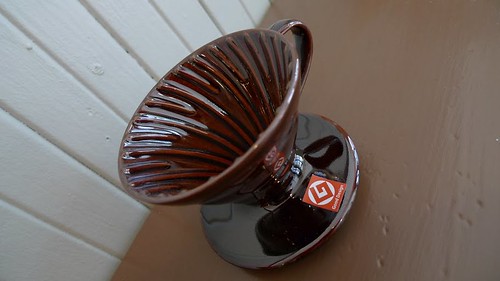
Affectionately called the 'mini' in house, this little brewer takes a small dose and brews rather quickly. Where the 2 cupper is around a 3 minute brew, this little bugger knocks a minute off and delivers a single cup. It's the opposite of those 8 cup Chemex that are all the rage right now. One regular sized cup of coffee.
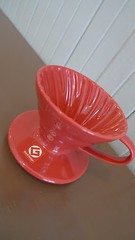 The little v60 is actually fairly simple to use. As long as the pour is even and the resulting grounds show an even, rather than lopsided dispersion, it probably brewed pretty well. The trick is setting the grind fine enough to get enough extraction and a slow enough draw down.
The little v60 is actually fairly simple to use. As long as the pour is even and the resulting grounds show an even, rather than lopsided dispersion, it probably brewed pretty well. The trick is setting the grind fine enough to get enough extraction and a slow enough draw down. Remember to add a bit of pre-infusion to let the grounds bloom before pouring. 30-40 seconds with a couple of ounces is usually enough. For more info, get a detailed care/brew guide from the web store.
Saturday, August 29, 2009
New v60 gear
We have a new cutie, the range server that matches the style of the Hario kettle as well as some sweet new ceramic v60 in red and brown.
Limited supply on these items so take a long look and then check out our updated coffee list. The Kenyas are up and Soma will come back into product in the next two weeks, give or take.
Friday, August 21, 2009
Open House
Meet our crew and taste great Kenyan coffees!
Oh, and hand mills are back in stock as well as a few new goodies that will be available online soon!
Wednesday, August 19, 2009
Saturday, August 15, 2009
Replacing syphon filters
Once you remove the old cloth, boil some water to rinse the new cloth through. A trick Ben C. showed me is that you have to start with a warmed and wet cloth filter and stretch it tightly when tying it on. Taking a little time to rinse it with water and then stretch it out making certain there are no folds or areas of crimping at the edges before tying it tight is essential.
The reasoning for this is largely that the filter needs to be tight but also that the filter needs to set flush in position against the glass when brewing. Any crevices or uneven spots around the edge will allow steam bubbles to gurgle from the sides of the filter. This is uncontrolled agitation and will add unpleasant bitterness (not unlike whisking the grinds excessively during brewing). Make sure that filter sits flush when brewing.
Friday, August 14, 2009
barismo's Best of Kenya tour
barismo (169 Mass Ave, Arlington, MA)
Saturday August 22nd 2-4pm
barismo staff meet and greet with tasting.
Simon's (1736 Massachusetts Ave, Cambridge, MA)
Sunday August 23rd, 2p-4p
Manual brew bar featuring 4 Kenyan coffees.
ERC (736 Commonwealth Ave, Boston, MA)
Monday August 24th, 930a-1130a
Sample Kenyan coffees and learn about the estates.
ERC (44 Gainsborough St, Boston, MA)
Monday August 24th, 130p-330p
Meet the roaster and sample Kenyan coffees.
ERC (286 Newbury St, Boston, MA)
Tuesday August 25th 130p-330p
Sample Kenyan coffees learn about the estates.
HiRise (56 Brattle St, Cambridge, MA)
Thursday August 28th 2-4pm
Manual brew bar
View barismo - 'Best of Kenya' Tour in a larger map
Sonata series espresso
The three versions featured on our site are also featured at a few of our cafe accounts and have been tuned to develop specific profiles. Coffee is seasonal and components will change so don't get attached but this series is an attempt at having a transparent lineup of coffees where customers could evaluate and compare the different variations and still have be cognizant of the changes.
Each version has a distinct style but the symmetry is they are all four part compositions.
S3 - Sonata series 3
60% Moreninha Formosa (Brazil)
15% Helsar de Zarcero (Costa Rica)
15% Kiandu (Kenya)
10% Koke (Ethiopia)
Pralines and cherries dominate this espresso. A blend of 4 coffees tuned to yield a short but rewarding shot of espresso. Start at 1.75oz and walk it down, depending on how fresh the coffee is, as it approaches a tight ristretto it really opens up.
S4 - Sonata Series 4
60% Moreninha Formosa (Brazil)
20% Helsar de Zarcero (Costa Rica)
10% Kiandu (Kenya)
10% Nimac Kapeh (Guatemala)
Warm fruited aromas yield to a berried mix of fruit underneath. A blend of 4 coffees tuned to yield a complex fruit candy shot of espresso.
S7 - Sonata Series 7
67.5% Moreninha Formosa (Brazil)
15% Koke (Ethiopia)
10% Nimac Kapeh (Guatemala)
7.5% Helsar de Zarcero (Costa Rica)
Pralines, caramel, and light cocoa intermingle to yield a classic full double. A blend of 4 coffees tuned to yield a sweet caramel mid-tone espresso.
The components will change from time to time and the Brasil component is going to change soon so don't get settled on this. The idea is to stay transparent and avoid confusion. Soma will make a return shortly with a few reincarnations and new 2 and 3 component mixes will show up as we move along. All the four piece blends though will fall under this same name, Sonata.
Thursday, August 13, 2009
Cloth filter brews taste good
Cloth is annoying to clean. If you don't take care of the filter and let it dry out or store it improperly, it will taste like 'cloth'. If you bleach it or use harsh cleaners, it will distort or deteriorate. If you don't rinse it well, it will discolor quickly.
On the other hand, it provides depth filtration so you can get a nice oily balanced and clean cup of coffee from a cloth filter. It's no more difficult than the majority of methods and needs only an additional step or two of care to keep it in good shape.
What I personally find so enjoyable about cloth is the taste. The depth and simultaneous clarity that comes from using this filtration should be justification enough for any serious coffee geek to give it a spin. I guess that's what matters the most though, the taste, right?
I know that so much of the coffee community is looking for the golden brewer that is simultaneously cheap, easy, and produces great quality. If they pick two of those three, it might be more realistic but there will always be room for everybody from those searching for the perfect cup to those searching for the easiest one. Cloth filters just might fall to the side of those willing to put a bit more time in to get a better cup.
Monday, August 10, 2009
New labels
 Our first labels were a much bigger battle than they needed to be. I think that new businesses have these situations where everyone has an opinion and is trying to define the future of the company in one step.
Our first labels were a much bigger battle than they needed to be. I think that new businesses have these situations where everyone has an opinion and is trying to define the future of the company in one step.I think my first version of the label set the tone for our approach but style is often an organic thing that grows with the people putting ideas into it. Right now the labels are evolving to be a bit more geeky and help people discern how we brew. They keep the same information about the coffees but we have been thinking about ways to help our customers take home the experience they have at the brew bar.

New labels are going to strive to keep our transparent style but add brew specific notes for each coffee. BREW settings are for traditional cupping and french press style brews. The additional notes are specific to our catalog of brew equipment so take the time to calibrate with our website notes as we update them for each coffee.
Disclaimer: Methods are specific to our roast style and the brewers we carry. We advise the end user to not expect similar results from different roast style coffees using these methods or the same results using different brewers. Larger Syphons with different form factors and traditional drip roasts may need to be tuned significantly differently to which we advise you to talk to the roaster for their approach. Our pour over brew specs will not translate directly to chemex or aeropress so we advise consumers using those methods to not adopt the pour over suggestions on our bags for these methods.
*Printed instructional brew guides are available on request with any purchase.
Sunday, August 09, 2009
barismo expands!
I want to take a little time and say thanks to our staff for all the recent effort and help taking on new projects. It has provided Hong and I the room to focus on specific aspects of the business and grow others aspects quickly beyond our expectations.
A big thanks to Chris, Jamie L., Logan, and Lex for the efforts and input recently. Working in a growing new shop is often long hours but this group has made it a lot of fun and keeps me very optimistic. It is a credit to them that we are moving forward right now and are able to meet the increasing demands.
I will take a little time to talk about them more in the future as I am very proud of the mix we have working here.
Method guides
We will start sending out general method guides and care guides with items like the ceramic v60 and cloth filters. We will slowly be adding these to orders. Keep an eye out for notes on the shopping section about availability.
Saturday, August 08, 2009
A revised mission statement
In starting our business, we felt there was a gap in training and barista support, or customer service if you will, that led us to opening our own roasting outfit. That's the extremely abbreviated version but there is a key concept here.
Give people the tools to succeed.
I know, it sounds simple, but that was an earth shaking concept for us. Deadlines, contracts, posturing, and aggression are all too often the norm in this area. It took a little time for people to catch on to the concept that we were there with the genuine intention to support and help them. In every business, you tend to pay for the mistakes of those that came before you as much as you might also benefit from those same mistakes.
I believe that building trust starts from the beginning. Coming into every situation working on good faith hoping that investment and patience with any new account would lead to a healthy working relationship long term. Sure, we have parted with accounts and lost a legitimate return on the training and investment we put in with a couple of early adopters but I believe that is not a reflection of any lack in effort or good intentions on our part.
The most important aspect in building healthy relationships with those who represent our coffee is our employees. A manager or business owner must always be accountable for those who work for them. In fact, there is no greater statement about a business owner than the people they give the most responsibility to or let speak for them. It is in this one area that I think we really excel, having cornered the market on good hard working and well meaning individuals. Yes, we have some of the most head strong and independent people you could put in one room but that also has a bit of charm to it as they are full of good intentions.
We are very proud that our approaches in roast and brew method are tuned to a stylized interpretation of what tastes good to us. Taste being the imperative word. Meters and measures are fun so we use as much as we can for pragmatic purposes but they become entirely superfluous if the person using them refuses to taste the results. It is because of our own taste preferences that we have come to a unique style we feel separates us from the traditionalist coffee community. Our styles and brew methods are our own and we spend a lot of time tuning them to be proud of what we produce regardless of arbitrary standards set down by others.
We believe the measure of good taste is not easily attributed to charts and graphs or gold standards and this is why the barista is still essential. Interpretation plays a large role in what a coffee can be and this is where the roast and of course, the final stage with the barista is important.
Saturday, July 25, 2009
New gear
The other new items we are very excited about are the little 2 cup wood neck dripper and the ceramic v60's. The dripper is a stylish little hoop sock brewer that comes with a wood neck (hence the name) tied with a leather strap. The ceramic v60's are a great pairing with our cloth cone filters and make a stylish statement on any professional (or wannabe pro) coffee setup.
We have Abid brewers in shop for sale but offline only. Come in for a demo and pick one up before we sell out.
More updates to come and a user guide is still being put together.
Monday, July 13, 2009
Today's menu
Currently, there are no syrups or cocoas. We will add some sig type drinks using varied ingredients but that offering will change week to week and is of limited availability. Along those lines, we currently only carry whole milk from High Lawn farms and Crescent Ridge farms.
Coffee by the cup for today will be Kiandu (10oz Abid) and Costa Rica Helsar de Zarcero (10oz Abid or 8oz Syphon). The Zarcero is a new coffee that came to us in GrainPro and is exceptionally fresh.
That should give folks an idea of the coffee bar service at the shop right now.
Thursday, July 02, 2009
Independence day hours
Sunday though, we will be open from 10am to 5pm. Chris will be covering the shop and brewing up free coffee all day. I found a replacement burner so he'll be doing Syphon and pour over depending on interest as well as having Soma on bar all day.
Wednesday, June 24, 2009
New equipment arriving soon
The open house went over very well and we are working on a few little projects this week before we set longer hours at the shop starting next week. Even with the damp weather, in store sales have been brisk and we want to say thanks for all the local support!
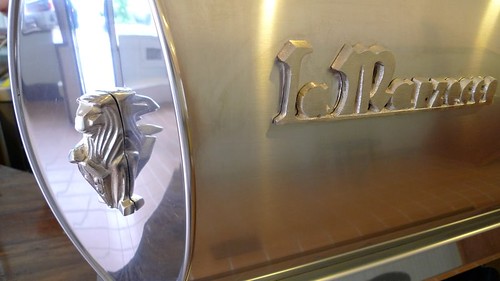
LM GB5, originally uploaded by coffeedirtdog.
We have a new shipment of equipment arriving soon. It is available for pre order to be shipped on arrival next week. Browse the shopping cart and check out what's available. We will
A lot of people have been asking for a method guide for pour over and I promise we will get something up here soon.
Friday, June 19, 2009
Let it rest
If you are going to pull it after day 3, keep it tight and avoid channeling but until it degasses a bit after opening the bag, it can be a little harder to work with. I opened a bag on day two that was giving me fits but recently was really enjoying two roasts that were 12 and 15 days off roast right out of the bag.
As to that, we sent out some coffees today for the MANE barista jam and for the PACA spro down. The barista Jam has a competition gong where you are given descriptors and you have thre shots to get the most out of the coffee. Should be interesting to see how they handle our espresso.
We have Syphons in stock again, TCA-2 and are a week away from a full shipment of Hario product. (for overseas orders, please contact lex@barismo.com before ordering) Local readers are going to see a lot of this product in the more reputable cafes. Hand mills, pour over equipment, you name it.
Tuesday, June 16, 2009
Open house: Sunday June 21st 12-6pm
barismo
169 Mass ave
Arlington, MA 02474
Free coffee and a chance to check out our new coffee bar are as good an excuse as any to drop by! See you there-
Saturday, June 13, 2009
'Full Immersion' Cold Brewers
 We have 8 cup cold brewers at the shop which are quite refreshing in the summer heat.
We have 8 cup cold brewers at the shop which are quite refreshing in the summer heat.For our coffees, we recommend 1g of coffee per 10ml water. A drip grind to almost a Syphon grind works best. Use cold filtered water and steep for 12-18 hours. For darker roasts, a shorter steep time of 8 hours can work well and some lighter roasts may need more steep time up to 24 hours.
Cold brew is very smooth and rewarding when compared to the many alternative iced coffee methods. It mellows out roast note and balances acidity while yielding a highly caffeinated cup. Full immersion cold brewing is quite easy to do and requires a few simple steps.
Load the ground coffee into the nylon filter. Add cold water. Steep for ~12 hours. Remove the nylon filter and coffee once a desired taste is achieved. Cold brew will continue to age and change over the next few days after initial brewing. It is important to note the change and plan to consume the coffee in the first week. We recommend the day 3 through 5 window after brewing as having the most complexity.
It also works for cold brewing tea as well, but rinse well or it will taste a bit like coffee. For teas, a heavier dose than you would normally use is preferable. Use loose leaf teas and tisane of your choosing. We recommend whole leaf teas like a dark Oolong or anything with clean and unbroken whole leaves for the best experience. Unlike hot brewed teas that are then iced, cold brew will stay clear and not become cloudy.
We have more Syphons on the way and a new shipment of equipment coming soon.
Monday, June 08, 2009
Building out the bar
 Finished up some details at the shop today. Need one more day to be done and then I can focus on the smaller projects.
Finished up some details at the shop today. Need one more day to be done and then I can focus on the smaller projects. One of the side projects was to get my old grinder back in shape so we broke it down and Ben C. stripped the paint, a little base coat, and some new color (finished paint job to be featured with some photos of the bar later). I think we will eventually get to the other 4 grinders but this one was travel weary and just plain ugly having had it for a while now.
The bar top took me a few tries to get it down to the right tint. Had to strip it down and redo the whole thing to get the right match but I am happy with the current color.
I figure we can have the machine up and running once the bar top is hardened enough for the equipment to set on it. Tough business taking on all these projects and working a normal job. I really do enjoy it though. Strangely, there is a sense of satisfaction in being tired and covered in paint at the end of the night. Truth is nobody truly appreciates the details until they do them themselves for their own benefit.
Details are important though. With all the national roasters in town recently scouting for victims, you'd think Boston was the next big thing in coffee. Maybe, but Boston is a funny place. Locals are fiercely loyal to established businesses. As a new roaster, I have learned that you have to stay around long enough to get entrenched and then people will begin to give you a chance. After you have been around for a while, you are established and nobody around here roots against a familiar haunt. I'm not sure how roasters in other shipping zones will fare coming into town but who really can say? There are some large shops now locally who are shipping in roasts from out of region but how sustainable is that long term? I believe that in a few years the larger coffee community will someday see an explosion of true micro roasters that will break the string of Regional turned National roasters we have seen in the last few years.
Part of our own business model right now is to begin a movement towards zero waste and we started by using as much reused material as possible in building out the kiosk. We already recycle as much material as we can and have more compost than we know what to do with but I am talking more about the build out as a starting point for a more aggressive stance. It's not something you would see on our print materials or something we will market because roasting is not a very efficient use of resources to begin with but it's on my mind as we move forward. We paid more for VOC free paints but the upside is they were full spectrum and that was worth it on many points. On the other end were the oak counters that took us a while to get cut and mounted, then stained properly. Luckily there is a local reclaimed wood outfit just off Alewife Pkwy and we were able to get some really unique and charactered pieces of Oak. It was a bit tough matching them up but I am pleased with the hours put in. For smaller projects like the standing counter, I salvaged an old kitchen table left behind by the previous tenants. After some cutting, planing, and a little sanding, it's set for service. I even went as far as to cut up some of the pallets that had hard wood to use as fly board under counter and some shelving.
The remodel moves to the office areas next but it will return late summer to the front to work on benches outside and taking down the air conditioning system for a more efficient one. We are measured for a bike rack out front to be installed soon. Something we volunteered for on our block but is really obviously necessary. I seriously wonder if the construction will ever stop or just have brief intervals.
Friday, May 29, 2009
Before the weekend
Our new site goes live soon. More on that later. Final bits of construction will happen this weekend. Much delayed but that's about how it goes.
GabeR was in town the other day, thanks for the photos! Merry 'corky' White was around the shop the other day. Anthropological type coffee studies in Japan. Book coming out soon, will keep our readers posted. She had taken some of my coffee to Japan and had feedback for us. She also brought a new gadget to muck around a bit with, thanks!
Coffees are on the shelf if anyone intends to make it out to Arlington. Later barista-
Thursday, May 28, 2009
Soma in the rock garden @ grumpy
Props to Liz on this shot.
That reminds me, Cafe Grumpy has some Kenya of ours and one of the locations has some Soma on guest. Three of our new crop Kenyas arrive in only a couple of weeks so keep an eye on our site.
Locally, I think the (Hi Rise brattle St.) has some Soma or will open some up tomorrow.
Kinda busy lately but that's a good thing. Thanks for the support!
Monday, May 18, 2009
Noodling around
That brings me to our Syphon method which has grown a lot over time. It either has to do with more experience or control over the roast. We did, once, try a glass rod and decided never to bother again. We tried paper filters one time and it was an incredible waste of time. Cloth is pretty much the best and if you think about the physics, it makes sense. You can't really beat depth filtration no matter how you hack or modify other filtration methods. Metal screens and glass rods will always need a slightly coarser grind and always have too much silt(one problem creates the other). Paper can provide a clean cup but it restricts fines and flow, traps oils, and often tastes strongly of paper unless rinsed religiously. Cloth is however, harder to keep clean and takes a bit more effort. It's hard to rinse it out after each use and before each use.
Sometimes I think the noodling done in our online forums and blogs is not a search for quality but trying to simply luck upon some particularly cool looking method using the simplest technique with the easiest cleanup (Like that nylon filter tried in Abid that was akin to brewing coffee in a swimsuit and tasted as such or the halogen lamp heater). I wish it was that easy, but the most rewarding methods take the most investment.
Truth is, the two best brews I have had in the last two weeks were a cloth pour over in a v60 and a Syphon. Therein lie two commonalities. Stable temps and depth filtration. The Syphon with our method is incredibly temperature controlled and the measured temp drop of our preferred pour over kettle is surprisingly small.
I now make an assumption that if the basic physics aren't there, don't bother. If it doesn't have a stable temperature or depth filtration, I might not like the results. You would think I might like chemex but the third component I always look for is an even extraction and loyal reader, I have yet to see a chemex methodology that gets just that. The v60 is comparable in visuals but has more side ventilation or 'drainage' which separates it from chemex. I have seen some forumphiles talk about analogies relating evenness to cooking a steak. The retort is that we don't want channeling in our espresso, why would we think it so romantic in our drip coffee? Poetic prose sounds good but it better have the taste buds to back it up.
Don't get me wrong, I care about a better cup and am not into rigid methodology. I just believe our approach as a community is often too loose and empirical.
I am not going to be diplomatic for our dear readers. Garbage in and simply put, garbage out. Without diligence and serious effort as input, you might be simply rolling the dice with varying brewing methods. On the other hand, if it tastes good to you, enjoy. If you are curious that it could taste even better, set up some variables to test and experiment.
Sunday, May 17, 2009
Micro and macro
I spend a lot of time worrying about how large is too large in regards to our long term goals. There are many reputable roasting outfits that are what I would think of as very large. The problem is that they are not quite large by general industry standards but by a layman's concept of size, they are on an obviously big scale to be romancing anything micro(thought they frequently do).
At what point do you lose control of quality as it relates to volume and output? In my eyes, there must be a point where quality roasting no longer means finessing and tweaking a roast but rather relates keeping the production consistent and avoiding problems. At larger volumes, it then becomes about repeatability and logistics instead of refinement and optimization.
I make this statement because I believe roasting in it's truest sense is about mass and momentum. When the mass gets large enough, it becomes very stable but harder to drastically change the momentum. It's the difference between a touring car and a dump truck if that analogy works for the reader. There is an obvious cutoff point where some more challenging roast profiles would no longer be achievable.
If this, then a larger batch size in a roaster becomes increasingly predictive and slow to react to changes. Obviously, this is a common observation, but the implication is that a smaller batch can do more unique profiles if the user has the ability to utilize this properly.
The problem is that smaller roasting outfits have very little access to (due to scale) better coffees. The smaller a roasting outfit, the more dependent it becomes on existing supply lines for coffees. In a business that deals in containers, a truly small batch roaster (unless well connected) is going to be locked out from some great coffees.
Simply put, a small batch roaster with knowledge and an adequate setup has more upward roast potential but little access to exceptional coffees. A larger batch roaster has less control over the roast in comparison but can consume more coffee and has more leverage to get any coffees they want.
It is very strange right now that our community, the online one, is not having this discussion yet. How big is too big to produce quality? How small is too small to have access to quality?
Tuesday, May 12, 2009
Up to date
I have classes in shop tonight and tomorrow night so though the place will look busy, we will be closed for these private functions.
I just brought on some new persons to help in several areas. For readers, that means a new website is coming soon with someone to monitor the shipping and updates. I need this to help refocus. It's easy to micromanage but I am the roaster and not a web guy. I spend hours behind the till and cupping production roasts so that's what I need to continue to focus on.
Thursday, May 07, 2009
Noting the name
Syphon Saturdays are a new thing at Hi Rise on Brattle St. I hear it's finally starting to get a little more headway and we hope people will go out and give it a push forward. Weather permitting, the patio will be a nice place to enjoy a beautiful Syphon experience this weekend. They have classic Linnaean St. named after the first place I lived by when I moved to Cambridge.
Taste has a batch of Soma right now on bar. For those of you wondering about the name, it has little to do with Brave New World, Nectar of the Gods, a song reference, or anything quite that complex beyond the simple etymology of a word. While reading up on the term, I noticed a bit that stated the word is derived from an Indo-Iranian root *sav- (Sanskrit sav-) "to press" and thought it too funny to pass up given all the alternative meanings and the misdirection it would provide.
On other espresso naming fronts, Simon's has this new blend reverting to an old name called 'You're Beautiful'. When Simon took over the shop from Hollywood Espresso, his visiting friends did a bit of art in several places around the cafe. One was a mirror placement that had Simon's face and the phrase'You're Beautiful' placed there. A delightfully cheeky statement that I was always fond of.
I wish naming was more complex or thought out but the components change and new names are defined by the coffees and profiles therein. Rather than trying to define a blend as a brand, we are going to have fun with it. Espresso is espresso and we aren't trying to rebrand a blend of coffees with an umbrella term for 'our espresso.' Keep it simple and rough, function over form. We are going to roast through a lot of coffees this year and there will be a ton of pairings to keep our barismo espressophiles satiated regardless of the identifier on the bag.
Friday, April 24, 2009
Get the coffee right
It seems to be that we are ready for the next stage (or stages rather). This weekend, the bar will get finished or pretty close to it. It will need a paint job and some shelving work but that will happen sooner than later. Shortly after, our hours of operation will firm up to reflect what we are. What we were was a wholesale roaster who happened to be open to the public during limited hours. We are now about to become a kiosk that will represent our coffees and tie together a few important items. Syphon, v60 pour overs, and espresso. No air pots, nothing but fresh brewed coffee.
To show what your coffee is, you either need competent representation (we have had that so far) or internal representation. We want to showcase a lot of brew methods and spend our time focused on the resulting cups at the shop and change the dialogue.
We came from an outside view of the dangers of rapid growth well beyond the ability to have effective quality controls. It was like watching an evolution where a multitude of compromises led to coffee in bins, black label blends, pre ground, hidden roast dates, and almost every single pitfall short of flavorings known to quality roasting. There was no feedback loop with accounts as to the results, no training, and very simply put, no barismo.
Our approach is going to be a direct response to those lessons which were taught indirectly. We are going to focus on training, focus on methodology, and most importantly taste. This is a mission statement in itself of making sure our coffees are executed at every step as well as we can influence it.
There is a time when the realization comes that you are surrounded and supported by an amazing group of people and the mix just needs to be fitted together in the right way. For that, we will be adding some new members to our family in different roles over the next few weeks. There have been more than a few phone calls in the last few days made to reach out and find the right mix.
I want to say thanks for all those who have supported us through the changes and see the potential in our style of coffee. To those who have hung around and been there at tastings, chipping in a thanks, or have been spreading the word, we appreciate it.
The kiosk is on the way. See you there soon barista.
Wednesday, April 15, 2009
Atlanta
The shop will be open 12-6 this week though may close an hour early on a few days. We had a ridiculously full roast session so expect there to be plenty of coffees. The SOMA is so good, I don't expect there to be a whole lot left by the weekend but Simon's has guest of it and some Nimac as espresso this coming week. We are going to limit SOMA to the kiosk or as a guest for other cafes right now. Hoping the kiosk will progress farther after a return from travel and we can showcase this blend a little more. It is the most complex espresso we have roasted yet.
See you next week barista.
Espresso pack
The blend consists of 10% Nimac Kapeh, 15% Kiandu, and 75% Cardenas. That's two Guatemala Atitlans and a Kenya Nyeri.
Sweetness, viscous mouthfeel, and ripe fruit dominate the cup character. Balance from top to bottom makes this smooth blend less challenging but still overtly complex. Front of the mouth cask conditioned red wine yields mid palate to soft cocoa, then finishes with sweet lingering spiced fruit jam.
It's a thick dark red shot that pulls well as a 19 gram double @ 201.5f and at shorter volumes.
During the WBC we are offering an espresso pack where you can pick up our three current blends at a reasonable price.
Tuesday, April 14, 2009
How I spent Easter
Highlights of the day were taking JP for lunch at what was his first try at Mexican food and then getting his reaction as we dropped into a couple of cafes. Much of the day was spent trying to get a firm idea on Rwandan cuisine, comparing roast styles, pulling shots, and the likes. On a personal level, it is great to work with people who want to learn and willing to absorb anything you can throw at them. So much of my time gets spent dealing with drama and non coffee stuff that it's refreshing to just work on the coffee.
The big lesson was that this is something we do enjoy doing. While Ben K. might occasionally risk burning down Hi-Rise for forgetting to turn off grills and be averse to mops, he is good at training for competitions. On the oddball notes, JP brought only a small amount of his competition coffee, Kivu with him so we had to arrange a little more coffee. Ben K. contacted his friend at Terroir and got a little of their current Rwanda for JP as a backup. I was not prepared for how difficult this coffee would be to roast. It was not anything in the behavior itself but the oddity was in coloration and the core of the roasted bean. It was hard not to burn and strangely difficult to roast. I have no real clue why but it was a bit like if Rod Serling wrote the script and we suddenly were having tipping and scorching when the roast should be too conservative as is. There is a lot of pressure when a last moment competition roast comes in for the World Barista Competition. We did get him a solid roast to work with and JP will have many other things to think about besides the coffee in the next few days.
Saturday, April 11, 2009
Three barismo things to think about
The anti boiler prototype got us thinking that it could revolutionize how we look at manual methods. Instead of trying to automate, use science to refine and support the execution of methodology. A firm time line for production does not exist but it really does hold some incredible potential.
The weather stinks right now but later this week you will be able to try a new espresso blend that will be available only as a guest at Simon's and Hi Rise on Brattle St. We need to settle it a little more but the espresso currently called SOMA consists of Cardenas, Kiandu, and Nimac. Depending on the feedback and final results, this will be a stock barismo blend going forward. As new crops come in, we will be running more SOE offerings and playing with experimental blends at shops that are geared up to run two espresso simultaneously (a guest/SOE being the second offering). Since our espresso machine is somewhat offline right now, we will see how things go but there will not be any on site activities at the lab until the kiosk remodel is finished.
Friday, April 10, 2009
Let the line flow
Knowing how cafes run and having ideas on how the lines flow is a tricky business. The design Simon originally had was not his own, he took over another shop and did only superficial changes. After years of watching the customers cluster and have trouble moving the line, he made some nice changes in this remodel. In an interesting way, it is a parallel to what we are going through in the lab right now.
Ben Chen pointed out to me today that the barismo layout is pretty symmetrical with our new counter installed. It still lacks a counter top but his estimation is correct. When you first walk in the door, you walk right up to the counter where ordering happens. It's a subtle thing but it influences the flow. Order with the person pulling shots, pick up on the other side of the machine down the counter, then pay a little further down the counter. At each of those moments, a step forward. Don't underestimate the psyche of a customer. Something as little as making a step forward every now and then feels like progress where as standing and waiting can feel frustrating.
The worst thing I see in cafes is when a line backs up at the drink pick up point and there is a small group of customers waiting for drinks. There will always be the person who hears exactly what you said and will still pick it up regardless of how wrong the size is querying 'Is this mine?' More times than you would like, this person will walk off with the drink forcing the staff to remake drinks and do damage control.
The second worst flow is the criss cross design. A condiment station or drink pickup area that forces customers to flow back through the line that moves forward to access the station. Having a register past the espresso machine but drinks are ordered at the register is always a fun thing to watch as a customer. The old shout out to figure out who went and sat down leaving the abandoned drink for half an hour only to come back later confused they did not have their drink yet.
Shop design is tough and there are few places that really nail it. I guess we are looking to maximize customer space in a tiny shop and move the line. I have learned some lessons from the other shops I've worked at or visited and I decided to keep it tight and efficient. No barista self indulgence this time around. Resulting success still to be decided.
Tuesday, April 07, 2009
Changes on the horizon
Part of that means the shop is an incredible mess but the barismo remodel is at a stopping point for a few days. That means after a cleanup, we will have a few days to catch up. A new counter, shelving, and a multitude of little organization projects will keep me busy pre World Barista Championship travel. After that, we should be up and running to get the kiosk cranking. Shots, cappuccino, cloth pour overs, and Syphons oh my!
Simon's has a custom version of the L. St. espresso blend forhis main espresso more focused on body and mid tones. Ask for it short and you will be rewarded. I am pretty excited by some of the shots Lauren has pulled me there lately and I recommend looking for her to pull your shot. She really seems to be an up and coming barista to keep an eye on. This week, Hi-Rise on Brattle St. will have Nimac by the cup in pour over. Judson is slowly developing his mix of coffees for per cup offerings there and it will take a little time to see it expand but I am hopeful that it will be something special. My former workmate already has good espresso (classic Linnaean St.) and teeny tiny cup sizes but the per cup program looks like the real wild card. On the other side, Vicki Lee's is half way through a long training schedule and will be an interesting test of what we can do in a lunch type setting. In time, we hope to do something very creative with them but they are just some of a few projects we have right now that we are very proud of.
Things in this town change quick and the barista jam was one of those that shows there is promise here. This town isn't locked in yet to any one style and there is much more yet to be written. Who the players are is the real question to be answered in the next few months.
Sunday, April 05, 2009
Flawed brews and the benefit of understanding
What I am getting at is that in our young coffee culture, our methods shift too often for reasons that are little more than a flawed initial interpretation.
We started with a version of pour over that was acceptable but have been playing with new equipment for the kiosk that makes me think we had ventured in the wrong direction for a little while. It happens a lot. Right now, the brews are coming out as good as our Syphon brews but with a different profile emphasis.
Coffee isn't simple, in fact, it's more complex than it should be and that's the basic problem. Our barista culture is always looking for the shortcuts. Skipping steps, trying to create a new approach that is simpler, easier, or gets results quicker. There is an inherent danger in this. As I see it, an inflexibility happens with ownership of a method. By changing the original method, it becomes personal, therein defense of the method becomes rigid even in the face of contradicting results. In short, we change it, we own it, we then defend it even though it may possibly be wrong. What's worse is there are very eloquent speakers in our community who pass prose for science but it's little more than empirical data given romantic aspirations.
This is a flaw in our current coffee culture which is justified simply because there is a very weak base which the new wave of coffee people can build upon. There are no forefathers of the pour over movement around on bar to give advice. No syphon masters locally to compare notes with. This is good because there is no rigid methodology and the options are wide open but bad because there is nothing to compare to. There is no great coffee culture here beyond the multitude of faceless airpot brewers which are often programmed with refractometers and spreadsheets. How does it become that taste is no longer part of the equation but graphs and charts are the end measure in many roasting outfits? What should we as barista gain from this?
Given this, it's easy to throw out everything and rewrite the book as you see it. To adopt your own independent methodology over how you brew. The problem is that without a base to begin, finding a good method or approach is about taking a lot of wrong turns. A good method is built upon scientific method, testing, repeating, and analytical approach. Most people in our culture don't have the time or patience to spend months roasting before going into production. They don't have time to pull a thousand shots or brew hundreds of brews to figure out and refine a single approach. They wing it, adjust, and all too often fall in love with their own approach even if there are gaping holes in it.
I think it's good to have true peers to give you a reality check. To tell you your pour over is just under extracted or that your bar routine is too inefficient. To pat you on the back when you make great gains or represent yourself professionally. Without that, the route to getting better is a longer tribulation than it should be and may be full of dead ends. Getting better depends on having respected peers be they in Taiwan or across the town line.
This is why I believe in a local community. If we simply hole up in our spaces behind terminals on the internet, we can debate all day and make careful arguments. Mostly rubbish but furiously typed nonetheless. It has little worth because of the distance of contributors and the lack of a commonality, the shared cup of coffee to sample. If we do not venture from our own cafe, how do we ever really experience this?
Our real peers, those that can taste our coffees and may then understand us, are the ones that matter most in our improvement. They may not agree but they can taste what you taste and that's the real key to getting better and raising the proverbial bar. Method grows from competition and understanding. The base of knowledge is built on a foundation not within a single roaster/cafe culture but in competitive improvement across many. To get better, there is a certain point at which we must understand others and learn from them, even challenge them and tell them they are wrong once in a while.
Growth is not always a singular movement. Often, it is a shared movement whether we like it or not. Those who benefit are often those who participate and the real challenge is to participate. To grow may in the end require that others grow with you.


